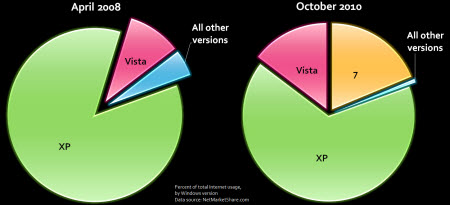Microsoft vs. Apple: Who's winning? The numbers don't lie

Microsoft has been at the top of the heap for almost as long as people have used PCs. They've managed to sustain an overwhelming competitive advantage, even after a decade's worth of antitrust action and the astonishing transformation of Apple into a profit-making machine that has built one billion-dollar business after another while the entire rest of the tech industry is stuck in neutral. Indeed, the presence of Apple and Google as direct competitors suggests that maybe Microsoft is overdue to take a tumble.
There is never a shortage of Apple-versus-Microsoft yammering in the blogosphere, but I haven't seen much in the way of actual data. Is Apple really making a dent in Microsoft's long-standing Windows monopoly? Are mobile devices like the iPhone and iPad taking over tasks that used to be done by PCs? Sales figures tell part of the story, but in my opinion the best data comes from analyzing how devices are being used in the real world. I went off in search of hard numbers, and I found them at the same source I used earlier this year to measure Windows 7 adoption rates (see When will XP finally fade away?).
Net Market Share publishes snapshots of PC usage based on data from 160 million visits per month to its large collection of sites (the exact methodology is here). Its monthly reports on operating system versions contain a wealth of detailed information about even the most obscure OSes, and they've tracked the performance of mobile platforms consistently for the past three years. To compile the charts in this post, I went beyond the simple summary reports and dug deep into the details, recording and cross-tabulating data for desktop and mobile OSes from November 2007 until October 2010. I found four unmistakable trends.
Windows XP continues its steady decline. In early 2008, more than a year after Microsoft launched Windows Vista, Windows users had emphatically rejected that upgrade. Fewer than 10% of Windows users had switched, and nearly 5% of all Windows PCs in use were running Windows versions older than XP. The Windows 7 story is very, very different. One year after the release of Windows 7, it has made a significant dent in the Windows user base, and those diehards holding on to pre-XP versions have mostly surrendered. XP's share of actual usage has declined more than 20 percent in two years, and that trend is accelerating.

There's no evidence that the marketplace is abandoning Windows to any significant degree. The overall share of Internet traffic from Windows PCs has dropped slightly in the past two-and-a-half years, from 95.4% to 91.1%. But that's true across the board for competing desktop OSes as well. Linux usage is down dramatically in 2010, to 0.85% from an all-time high of 1.08% in early 2009. Interestingly, OS X usage is also down, dropping by roughly a quarter of a percentage point since a year ago, from 5.26% to exactly 5.00%. In relative terms, that's almost exactly the same overall drop as the Windows platform has seen in the same period.
Apple is still gaining on Microsoft, thanks to iOS-based devices. There's no doubt that the Mac has been a big success for Apple over the past couple of years. While Microsoft was stumbling with Vista, Apple used a very aggressive advertising campaign that resulted in considerable growth of OS X usage, at least in relative terms. The Net Market Share stats confirm that OS X's share of Internet usage rose from 3.45% in early 2008 to more than 5% last year. As I noted earlier, the Mac's momentum has stalled (which might explain Apple's sudden "Back to the Mac" event last week). But Apple's overall share of the Internet continues to go up steadily, thanks to mobile devices like the iPhone and iPad. Added together, Apple's one-two punch of OS X and iOS has been a clear winner. It will be interesting to look at these figures again in a year.
The mobile Internet is growing at an astonishing rate. This was the most fascinating set of numbers to me, and they're also the ones that should have Microsoft most concerned. Back in 2007, Internet traffic from mobile devices was nearly nonexistent; today, mobile operating systems account for nearly 3% of all Internet traffic. The percentage of Internet usage on mobile devices has been doubling every eight months or so. If you extrapolate that trend, it's easy to imagine a world in which mobile devices consume 20% or more of total Internet usage within the next two or three years.
So where is all that traffic coming from? Not surprisingly, Apple's iOS-based devices are the leader in the mobile category, as measured by usage, accounting for 42% of the total traffic from mobile sources. The very close runner-up, at 37%, is a big surprise: Java Platform, Micro Edition (Java ME), presumably running mostly on Nokia feature phones [and on BlackBerry devices as well, as several commenters point out in the Talkback section]. Symbian is a distant third at 11%, with Android in fourth at 8%.
We are indeed moving rapidly into a world where mobile devices are taking over many tasks that were previously handled by PCs. The big question is whether (and if so, when) that growth curve levels off. This is a market that is only beginning to explode, which means things can change very quickly. I'll be looking closely at these monthly numbers over the next year, especially with Microsoft jumping into this space so aggressively with Windows Phone 7.